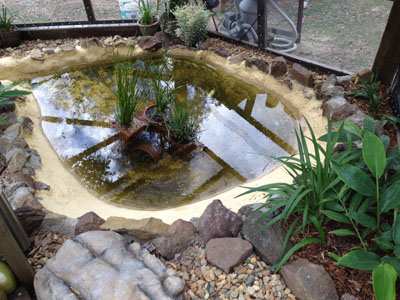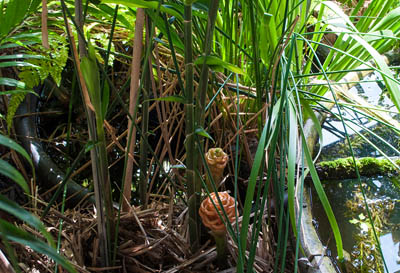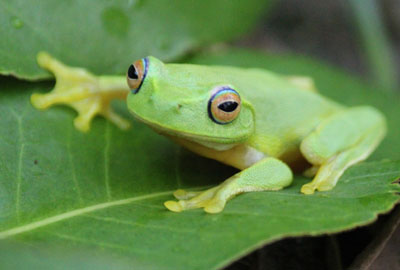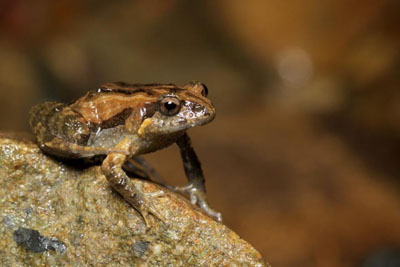of our environment and protecting our local frog populations from decline.
Frogs (and tadpoles):
- are an important link in the food chain
- help with insect control
- are an indicator of the health of micro-systems (due to their
permeable skin and sensitivity to change or chemicals) - help control algae levels in ponds
What do frogs need?
-
A place to hide, from predators and hot, dry conditions
Frogs shelter in many places depending on whether they are ground-dwelling or arboreal (tree climbing). Frogs naturally prefer cooler, moist places. This can be achieved by the careful placement and partial burying of terracotta pots or ceramic pipes. Provide thick leaf litter with rocks and logs to hide in, and digging spots for burrowing frogs.
-
Food
Adult frogs are insect eaters. It is relatively easy to attract insects to your frog area.
- Install solar lights that turn on at dusk to attract moths and other flying insects at the right time for the frogs.
- Good selection and density of plants to encourage insect life providing a variety of food options for your resident frogs.
-
A place to breed
Most frogs require a permanent source of moisture to successfully breed such as a pond, dam or river. Providing clean water will in turn provide a stable breeding site. Different frog species have different breeding habitat requirements, so read up on your local frogs and their specific requirements.
Build it (right) and they will come!
Before you begin, look around as you may be surprised by what you find and where. Particularly take notice of the natural lay of the land. You can use low-lying areas to your advantage; these make ideal hideaway spots for frogs that are enhanced by strategic positioning of logs, rocks and other suitable hides. Extend these features into water if possible, they are essential shelter for frogs from predators and weather. Remember to check for the location of pipes before digging! There are no single
rules for constructing a frog suitable habitat and the adage of ‘many roads lead to Rome’ rings true.

 Above: Jada and Jules, resident Green Treefrogs at the author’s pond. Below: A dedicated area the author constructed to house a group of
Above: Jada and Jules, resident Green Treefrogs at the author’s pond. Below: A dedicated area the author constructed to house a group ofsix captive Eastern Water Dragons and which also supports a healthy frog population, with at least four species present. Bottom: Pots and dense plants make good refuges for frogs, providing protection from predators and hot, dry conditions. Use local native plants to support the insects that frogs feed on and to provide for other wildlife.
 Graceful Tree Frogs can be difficult to find when sheltering from the sun, as they tuck their legs in tight, close their eyes, and are just a small green bump on a leaf or stem.
Graceful Tree Frogs can be difficult to find when sheltering from the sun, as they tuck their legs in tight, close their eyes, and are just a small green bump on a leaf or stem. Clicking Froglets shelter under logs and other debris, usually near water and males can be heard day and night, all year round.
Clicking Froglets shelter under logs and other debris, usually near water and males can be heard day and night, all year round.Location
- Water areas may be a hazard to small children so you may need to make plans to reduce risk and provide child-friendly fencing.
- Frogs can be quite noisy with the onset of rain or the breeding season so choose the location of your frog-friendly area carefully!! You may need to select a spot well away from your
and your neighbour’s windows. - Domestic animals can be a major threat to the survival of frogs and other native wildlife. Keep free-ranging chickens, dogs and cats out of your frog-friendly areas.
- Position your pond two-thirds in shade or use plants to provide shade (avoiding deciduous and toxic plants). Sunshine is needed for plants and to provide algae for tadpole food, too
much is detrimental to water quality. - Remember never to use pesticides on insects around your house as these may then poison your frogs. Let your frogs do the work on pest control!!
Structure
- Vary pond depth to include deep (cool) areas for the warmer months and shallow areas for easier frog entry and exit. This also allows tadpoles of different species to select their preferred water temperatures, increasing likelihood of morphing into frogs.
- Keep Cane Toads out! This means creating a 60cm high physical barrier, and extending this into the soil if your pond is at ground level. Or simply monitor your pond regularly and remove Cane Toad eggs when found.
- Avoid steep walls as small frogs may drown if they cannot exit easily.
Content
- Fill the pond with rainwater. If not possible, use tapwater treated to remove chlorine and fluoride.
- Provide loose substrate to support aquatic plants and invertebrates (another food source for frogs).
- Densely plant shallows and provide a variety of emergent, submerged and floating plants, preferably native species.
- Most fish eat frog eggs and/or tadpoles, however smaller species of the following native fish groups are frog-friendly and will help with mosquito control: blue eyes, smelts, hardyheads, Galaxias, pygmy perch, rainbowfish, carp gudgeons.
- A well-designed frog-friendly area will attract local native frogs. DO NOT relocate eggs or tadpoles from other areas to your pond, this is detrimental to the frogs and against the law. Be patient…they will come!
- Globally frogs and toads are struggling. There have been significant declines related to pollution, loss of habitat, global warming, use of chemicals and the spread of disease, such as Chytrid fungus.We can all do our bit to help local native frogs to stay ‘common’ and not end up on the threatened species list.
Land for Wildlife member
Jimboomba, Logan
President, Reptile Rehabilitation Qld

hi are guppies ok?I am guessing not as they are not in the list .
Hi Jennifer. Guppies are native to South America. The Land for Wildlife program would encourage you to stock fish ponds with native fish rather than introduced species, because the introduced fish often end up in our waterways.
HI I am a teacher at Boronia Heights State School, and we are trying to create a frog friendly habitat in fenced area that contains at this point an above ground pond with the ornate rainbow fish in it and some plants, I was wondering if you or someone else with expert knowledge would come and have a talk to my eco group , a look at the area and give us some tips to make the rest of the area frog friendly.
Hi Lisa. I have passed on your request to the Land for Wildlife team at Logan City Council and hopefully they will be able to help you.
Hi. Just wondering suggestions for keeping toads out with a 60cm barrier… what do you suggest or do you have any ideas/examples to use in a backyard? We have seen ponds made in raised garden beds would that work? Thank you!
I have seen different barrier/wall options from bricks to timber sleepers to having an above-ground pond with high walls (e.g. a former water tank inverted with sides cut down). Alternatively, you can have a ground-level pond and just be vigilant about controlling toads.
Hi,
We seem to have a green frog (Brisbane/Newport area) that appears in the evening and hangs around, disappears by morning, its a new development area, find it in the dogs bowl of water!!
So Question is shld we put some things in and around to help or the fact that its already hanging around is fact enough its happy with what ever its doing?
Like to “help” if we can or if its needed
Hi Peter. You may wish to set up water point specifically for wildlife, like frogs. Some tips are in this article https://www.lfwseq.org.au/the-importance-of-water/
Hi Lisa, can I make a small pond in a large shallow pot (22 cm high x 45 cm wide). Would make a little cave with a pot on it’s side and some water plants and river gravel on the bottom. Fill it almost full of water. And put the whole lot under our pergola in a shaded spot. Oh and put a solar powered light near it to attract the insects. Will the frogs like that?
Hi Michael. You can certainly give it a go. Depends on where you live and how quickly the shallow pot will dry out. Different species of frogs need different habitats to breed and a shallow pot might not be enough for some species. No harm in trying. Just try to avoid creating mosquito habitat! Cheers.
Hi I’m in SW of WA and have a large pond which usually has heaps of frogs and tadpoles. In the last two months I’ve found 3 dead frogs and have another sick one with a hugely swollen leg! What should I do? Haven’t used any poisons or changed anything. There’s a fountain and water lillies have also died not just sleeping. Thanks
We have a frog or toad that lives in our yard drain pipe. It is moist but does not gush water. Since it is by the road , I fear it will be hit by a car. What can I put in my garden to entice it away from that area.
Hi I have a lovely pond close to my house. I already have several Gracious / white lipped tree frogs living around the pond. I have noticed about 40 tadpoles in my pond. Will all of these stay around the pond when they mature to frogs? Or will they move on ? If not I’m going to have a lot of frogs 🐸 !!!
Hi there, what is the best way to treat tap water?
Thanks,
Marc
It seems this website isn’t being updated.
I suggest contacting FrogSafe https://frogsafe.org.au with any questions. They are based in Nth Qld but were very helpful with my Qs about NSW frogs.